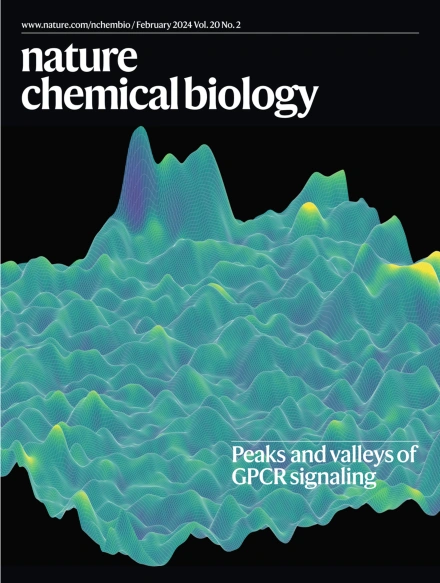苯胺类药物与核糖体上的一个独特位点结合,抑制蛋白质合成
IF 12.9
1区 生物学
Q1 BIOCHEMISTRY & MOLECULAR BIOLOGY
引用次数: 0
摘要
低温电子显微镜观察到的苯胺灵滞留核糖体结构显示,它有一个独特的核糖体结合位点,位于 A 位点和 P 位点 tRNA 之间。其他生化试验表明,苯胺灵通过阻止 mRNA 和 tRNA 在延伸阶段通过核糖体的运动来抑制蛋白质的合成。本文章由计算机程序翻译,如有差异,请以英文原文为准。


Paenilamicins bind to a unique site on the ribosome to inhibit protein synthesis
Cryo-electron microscopy structures of paenilamicin-stalled ribosomes showed that it has a unique ribosome-binding site located between the A- and P-site tRNAs. Additional biochemical assays demonstrated that paenilamicins inhibit protein synthesis by blocking the movement of mRNA and tRNA through the ribosome during the elongation phase.
求助全文
通过发布文献求助,成功后即可免费获取论文全文。
去求助
来源期刊

Nature chemical biology
生物-生化与分子生物学
CiteScore
23.90
自引率
1.40%
发文量
238
审稿时长
12 months
期刊介绍:
Nature Chemical Biology stands as an esteemed international monthly journal, offering a prominent platform for the chemical biology community to showcase top-tier original research and commentary. Operating at the crossroads of chemistry, biology, and related disciplines, chemical biology utilizes scientific ideas and approaches to comprehend and manipulate biological systems with molecular precision.
The journal embraces contributions from the growing community of chemical biologists, encompassing insights from chemists applying principles and tools to biological inquiries and biologists striving to comprehend and control molecular-level biological processes. We prioritize studies unveiling significant conceptual or practical advancements in areas where chemistry and biology intersect, emphasizing basic research, especially those reporting novel chemical or biological tools and offering profound molecular-level insights into underlying biological mechanisms.
Nature Chemical Biology also welcomes manuscripts describing applied molecular studies at the chemistry-biology interface due to the broad utility of chemical biology approaches in manipulating or engineering biological systems. Irrespective of scientific focus, we actively seek submissions that creatively blend chemistry and biology, particularly those providing substantial conceptual or methodological breakthroughs with the potential to open innovative research avenues. The journal maintains a robust and impartial review process, emphasizing thorough chemical and biological characterization.
 求助内容:
求助内容: 应助结果提醒方式:
应助结果提醒方式:


